Patsy Trench's Blog, page 5
February 12, 2021
All We Need is Love
‘True love is like ghosts, which everyone talks about and few have seen‘
François de La Rochefoucauld

My anthology of short stories about love in adversity is out TOMORROW, Saturday 13 February, just in time for Valentine’s, at the Incredibly Inexpensive (and Introductory) price of $0.99 (£0.99), ebook version.
It is available to pre-order on Amazon here: https://mybook.to/AllWeNeed
Whether you love Valentine’s Day or you hate it, there is a story here for you. But a warning: these are not romantic stories. Love may make the world go round, and it may be many-splendoured and all that, but as we all know it’s not that easy to find. To misquote Oscar Wilde: ‘Love is rarely pure and never simple’.
For a sneak peek at the Introduction, click below:
https://patsytrench.com/wp-content/uploads/2021/02/Introduction-2.pdf

© Patsy Trench
London 2021
The post All We Need is Love appeared first on .
January 8, 2021
SURVIVING LOCKDOWN: The joy of small discoveries
By and large we writers are suffering less than most people during lockdown (unless we have small children to home-school, which is another story altogether). We are used to working from home, we are used to spending time on our own – along with our characters of course. And there are no distractions.
There are minor inconveniences of course: not being able to get out and about to libraries – the British Library in particular – or museums, galleries and theatres for inspiration, not to mention parts of London one might ordinarily want to visit, for research purposes or perhaps even for pleasure.
 Trafalgar Square in lockdown (bbc.com)
Trafalgar Square in lockdown (bbc.com)Small discoveries
But one of the small pleasures I have experienced of lockdown is what I call the joy of small discoveries. For example as I heard the other day, the British Museum has found mysterious cracks appearing in some of their artefacts. It turns out that without the usual thousands of daily visitors, or more precisely their breath, the air inside the museum becomes so dry it damages some of the exhibits. This is not too much of a problem for the BM as they can just turn up their humidifiers, as I imagine can the larger art galleries.
From the same source[1] I heard that when you are asked online to prove you are not a robot by annoyingly having to identify which of the eight tiny squares on your tiny screen have traffic lights or cars in them, you are contributing to research into driverless cars. I’m not quite so sure how reliable this is (and if it is why aren’t they paying us? I can’t help asking), but if it’s on BBC Radio 4 then it must be true, mustn’t it?[2]
19th century theatre
Also, and more particularly to the point for this novelist looking into theatrical history in Victorian and Edwardian times, I was surprised to see how many women played such major roles, both on stage and more particularly, off. Acting was one way a woman could earn a living in the late 19th century without causing too much of an uproar (unlike fifty years earlier when she was regarded as no better than she should be), and many of them wielded considerable power. Mrs Patrick Campbell (who features in my novel The Purpose of Prudence de Vere) not only played starring roles on stage, she also produced several plays in her own right, as did actresses Ellen Terry and Sarah Bernhardt and other less well-known women such as Gertrude Kingston and Genevieve Ward.
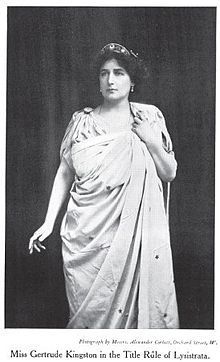

 Gertrude Kingston as Lysistrata (Wikipedia), Genevieve Ward (Wikipedia) & Mrs Patrick Campbell (from The Life of Mrs Pat by Margot Peters)
Gertrude Kingston as Lysistrata (Wikipedia), Genevieve Ward (Wikipedia) & Mrs Patrick Campbell (from The Life of Mrs Pat by Margot Peters)Messing about on stage
On a slightly more irreverent note, Mrs Pat was notorious for the pranks she got up to on stage when she was bored, such as chucking chocolates at the scenery.[3] She was not the only one. Herbert Tree, arguably the greatest actor manager ever (who features in my forthcoming novel) also played around when he got bored, by appearing on stage from the wrong place, or ad libbing (which he was prone to do anyway as he hated learning lines).
There is a marvellous book called The Truth about Pygmalion[4] about the first English production of Bernard Shaw’s play, which starred both Mrs Pat and Herbert Tree. Tree was a character actor who found it impossible to play straight roles. In rehearsals he gave Henry Higgins, on different occasions, a limp and a Scottish accent, on the grounds that every middle-aged bachelor drinks too much and has gout, and that most linguists are Scottish. It took all Shaw’s patience and self-control to get him to play without any accoutrements (and to stick to the script). Mrs Pat’s accent was so appalling it took Shaw considerable more ingenuity to teach her to speak cockney than it ever did Higgins to teach Eliza to speak posh. Then on the final week of rehearsals Mrs Pat disappeared completely and her place was taken by an understudy. She turned up out of the blue for the dress rehearsal as if nothing had happened. (She’d got married in the interim.) Meanwhile the moment the famously unromantic Shaw’s back was turned Tree added his own touch to the end of the play when he had Higgins throw a bouquet at Eliza.

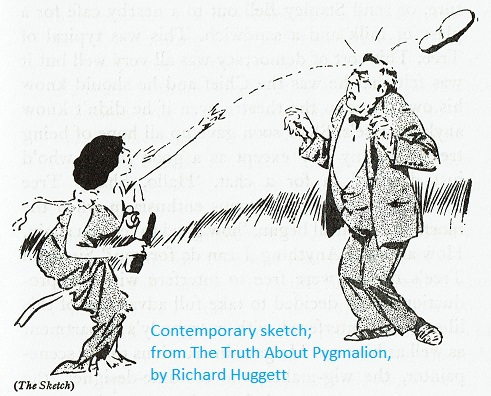 Cartoons from The Truth about Pygmalion by Richard Huggett
Cartoons from The Truth about Pygmalion by Richard HuggettThe Word
Pygmalion was also famous – or notorious – for the uttering on stage, by a woman, of a Word rarely heard outside the pubs and pits; a Word that has since been superseded – and how – by others far more intentionally offensive, but which at the time caused a furore in the national press. Tree was so nervous his audience would be irredeemably shocked he tried to get Mrs Pat to cut it, but she refused. In the event it brought sustained howls of laughter in the theatre, and once word had got around about the Word the theatre was subsequently packed out night after night.[5] It even became fashionable to use it among certain societies.
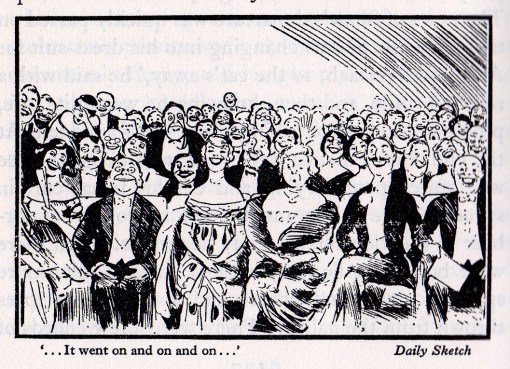 Audience reaction to The Word (The Truth about Pygmalion)
Audience reaction to The Word (The Truth about Pygmalion)How times have changed.
© Patsy Trench
January 2021
[1] ‘The Museum of Curiosity’, BBC Radio 4 https://www.bbc.co.uk/programmes/b00k3wvk [Probably not available outside the UK]
[2] I once worked years ago as a transcriber for a commercial company. One of our tasks was to transcribe verbatim verbatim – meaning including everything from ers and ums to coughs, throat clearing and any extraneous noise such as a dog barking or passing traffic – a series of apparently meaningless phone conversations between people who didn’t know one another. The point? They didn’t tell us until much later this was research into voice recognition for software.
[3] The Truth About Pygmalio, Richard Huggett
[4] By Richard Huggett, William Heinemann, London 1969
[5] The Word, in case you didn’t know, was ‘bloody’
The post SURVIVING LOCKDOWN: The joy of small discoveries appeared first on .
September 25, 2020
Claudia goes on tour
Claudia Faraday, like her author, is a shy and reserved woman who hates to draw attention to herself.

However in the big bad world of books, of which there are far too many, a person – and an author – does from time to time have to raise her head above the parapet and say ‘Here I am!’
So it was for this purpose that Claudia and I enlisted the services of Rachel’s Random Resources, who took us on a five-day blog tour last week in search of reviews. It was the most attention either of us had received ever since Claudia appeared on the scene back in 2015 (she was revamped in 2019), which was heart-warming to say the least. Here are some of the comments from the book reviewers:
I loved reading how Claudia really opens her eyes and sees a whole new world and starts imagining things she never thought of . . . For me, it was not purely a sexual awakening for Claudia, but more on an emotional level . . . A funny read, with an important message underneath! https://tizisbookreview.music.blog/2020/09/15/the-awakening-of-claudia-faraday-written-by-patsy-trench-bookreview-patsytrench-rararesources/
 Headline news?
Headline news?I really enjoyed this story and I thought that the author has a superb writing style that really brought the period, the characters and what they were going through and dealing with to life . . . Very highly recommended! https://donnasbookblog.wordpress.com/2020/09/15/blogtour-bookreview-for-the-awakening-of-claudia-faraday-by-patsy-trench-rararesources/
Thank you Rachel’s Random Resources for introducing me to Claudia Faraday. We went on an interesting journey together . . . Patsy Trench’s story has an unexpected elegance . . . The chronology in the journey of sexual awareness depicted in the story is one of the beautiful elements here. https://trails-of-tales.com/book-review-the-awakening-of-claudia-faraday/
. . . an interesting feminist take on sexual diversity. https://jessicabelmont.wordpress.com/2020/09/16/blogtour-the-awakening-of-claudia-faraday-patsy-trench-patsytrench-rararesources-gilbster1000-amreading-bookblogger-bookreview/
The Awakening of Claudia Faraday is a delightful novel which consistently confounds expectations . . . Claudia is a lovely protagonist. A gentle and well intentioned woman who, in her sixth decade, is only beginning to question her wants and desires . . . It is not a difficulty to spend time in the world of these delightful characters. https://pajnewman.com/
Patsy Trench writes a fun, easy and totally relatable story that translates well to current day . . . it’s a page turner that I know every woman can identify with in their own way and will absolutely love . . . With a really great cast of characters and a brilliant plot, I honestly have to repeat myself and say “you gotta read this book.” https://www.facebook.com/readinggirlreviews/
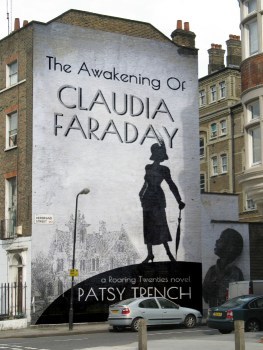 A bit of subtle advertising in a London street
A bit of subtle advertising in a London street Trench combines the charm of the early 20th century with a facet of womanhood that hasn’t really changed that much at all. We put the pleasure of others before our own, because society tends to deem it be correct that way. And goodness gracious me if one does endeavour to discover and enjoy pleasure, and demand it no less – well I never, what would people say? https://mmcheryl.wordpress.com/
A coming-of-age story set in the 1920s where the protagonist, Claudia, shakes off the shackles of a prim, well-to-do lady and discovers the joy of sex . . . Offering something a little different from other books, I think this would appeal to fans of the 1920s or historical fiction . . . It’s an unusual story that provides a different perspective on what it means to be a woman. https://mrsbrownsbooks.wordpress.com/

Photos courtesy of photofunia.com.
The Awakening of Claudia Faraday is available here: https://mybook.to/ClaudiaF
Patsy Trench
September 2020
The post Claudia goes on tour appeared first on .
September 13, 2020
Where did Claudia Faraday come from?
She originated in a short story I wrote some years ago, about a woman in her fifties and the mother of three grownup children who discovers the joys of sex for the first time.
‘It got better, in time, though to be truthful it always felt more of a duty than a pleasure: a little like homework, satisfying when over, and done well, but never exactly enjoyable. But then nobody had ever suggested it could be otherwise.’
That was Claudia talking about sex.
I was intrigued by the notion that for many women of previous eras sex was largely a matter of lying back and thinking of England. The idea that it could be pleasurable, and done not just for the sake of procreation, never seemed to enter their heads. Then along came Marie Stopes, who made the outrageous suggestion in her book Married Love that sex could be enjoyed for its own sake, and that there was such a thing as a clitoris – whose function was for the purpose of (self) gratification rather than producing babies – and, in her own way set the world of sex on fire.
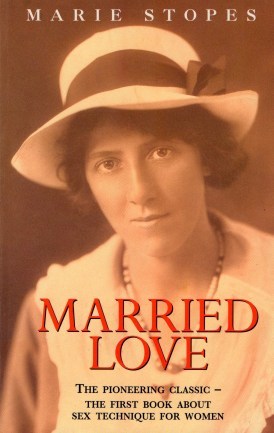 Originally published by A C Fifield in 1918
Originally published by A C Fifield in 1918(this cover from The Gollancz Paperbacks edition 1995)
But The Awakening of Claudia Faraday is not solely about sex. There is a bit of erotica of course. But it’s essentially – as the title suggests – about what the effect this new discovery has on a woman in her fifties, brought up in the rigid confines of the Victorian age and now, thanks to an unlikely happening, emerging into the bright lights of the Roaring Twenties: a time of bohemianism, Noel Coward and the Bloomsbury group; when women were shedding their corsets along with their inhibitions.
It’s a book about a reserved, impeccably-mannered woman of a certain age learning how to behave badly, you could say. What might have happened if Virginia Woolf’s Mrs Dalloway (whose name was the inspiration behind Claudia’s) had met D H Lawrence’s Oliver Mellors.
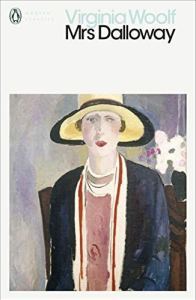 Mrs Dalloway, originally published by Hogarth Press in 1925
Mrs Dalloway, originally published by Hogarth Press in 1925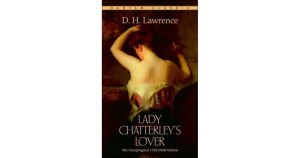 Lady Chatterley (goodreads.com), originally published by Penguin Books in 1960
Lady Chatterley (goodreads.com), originally published by Penguin Books in 1960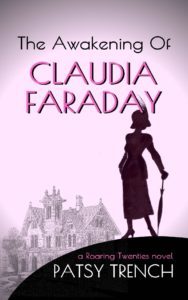 Claudia Faraday, originally published by Prefab Publications in 2019
Claudia Faraday, originally published by Prefab Publications in 2019© Patsy Trench
September 2020
The post Where did Claudia Faraday come from? appeared first on .
September 2, 2020
May Cottage revisited
May Cottage is a Grade II listed building and it still exists. However when I tried to visit it back in 2008 the current owners would not allow me past the back gate. All I had to go on, apart from official records, was the testimony, and some photos and floor plans, from a previous owner, the lovely – and now late – Olive Hall.
I knew May Cottage as a picture-postcard, two-storey thatched cottage with pink-washed walls. Two living rooms and a kitchen down, two bedrooms up. Not a lot of space for a family of six.
 May Cottage in Olive Hall’s time
May Cottage in Olive Hall’s timeThen a few weeks ago the current owner, Phil Leahy-Harland, contacted me through the Pitt family history website to say he was restoring the property to its original glory and I was welcome to visit any time. For the first time since I set out on my family history adventure I was able to actually set foot inside my ancestral home – which, incidentally, my family never owned – and patch together some kind of biography of May Cottage, thus:
The house was originally built in 1684 and was known as the ‘Trout Alehouse’. It was leased to Mary’s husband Robert Pitt in 1766, and it was licensed up until 1770, the year he married Mary and when, presumably, it changed its name to May Cottage. The cottage was owned by the local squire, Lord Pitt Rivers, and at the time of Mary’s emigration she and her five children were living there ‘rent-free’ – presumably because the family was on hard times; hence their emigration to make their home in a penal colony.
Up until 1968 the house was unmodernised. The elderly couple who owned it did not use the upper floor; they turned the smaller of the two rooms downstairs into a bedroom and showered – with cold water – in the kitchen. Their toilet was an ‘elsan’ outside the back door. Olive and her husband added a bathroom on the upper level, and at some point the two downstairs rooms became one. An extension was added in 1992.
 May Cottage with 1992 extension
May Cottage with 1992 extension Side view of extensionMay Cottage 1992. It looks immaculate from the outside but it was actually falling to bits.
Side view of extensionMay Cottage 1992. It looks immaculate from the outside but it was actually falling to bits.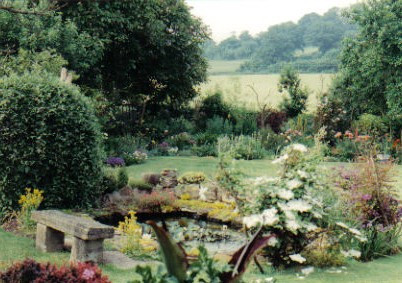 Olive Hall’s garden
Olive Hall’s garden Olive’s shed
Olive’s shed Aerial short of May CottageOlive Hall’s photos
Aerial short of May CottageOlive Hall’s photosMay Cottage might look immaculate from the outside but according to Phil it was almost falling down when he and his wife Sam bought it in 2015. The garden was a jungle and none of the previous restorations had been done properly. Gaps had been filled with Blu-tak, beams that had split had not been replaced, the walls and ceiling had moved several inches and were bulging in places. Fortunately for anyone who cares about these things, and especially for the Pitt family, Phil is now spending every spare moment restoring the place, with huge and painstaking care.
 May Cottage, August 2020. If you look closely you can see the pink rendering on the left part of the building, which Phil is removing to expose the brickwork beneath, which he is restoring and pointing.
May Cottage, August 2020. If you look closely you can see the pink rendering on the left part of the building, which Phil is removing to expose the brickwork beneath, which he is restoring and pointing.So was it what I expected?
Well the first thing that struck me was its size, and how Mary and her five children fitted into two bedrooms. The ceiling beams on which her cousin and patron George Matcham hit his head (in my book) isn’t quite as low as I had claimed, but the stairs leading to the upper floor were every bit as steep and uneven as I had been led to believe. Like all old cottages the windows are small (see below), so the place is dark, as I had correctly imagined.
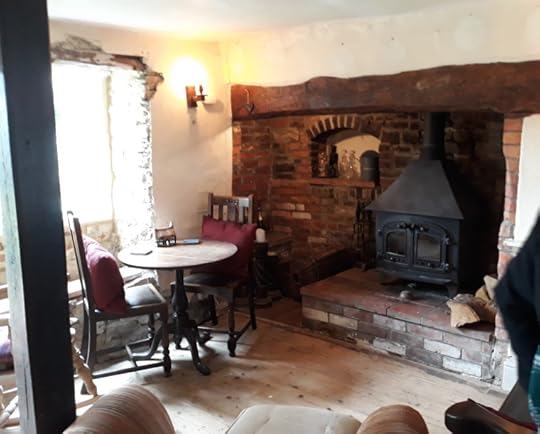 Downstairs ‘parlour’
Downstairs ‘parlour’ Main bedroom
Main bedroom Second bedroom[image error]
Second bedroom[image error]Thrillingly, Phil discovered, carved into the brickwork, the initials ‘W P’ – not once, but three times. Who was ‘WP’? Well he could be anyone, but I like to imagine he was Mary’s eldest son William Pitt (who vanished to America and subsequent oblivion).


 Old carvings in the brickwork and a timber window frame. The first and third are easily recognisable as ‘WP’. The second is harder to decipher.
Old carvings in the brickwork and a timber window frame. The first and third are easily recognisable as ‘WP’. The second is harder to decipher.  Original outer back door
Original outer back door Interior wall showing original lath and plaster, and wallpaperOriginal features
Interior wall showing original lath and plaster, and wallpaperOriginal featuresThey have also discovered, in the hedgerows and in the skirting board, various items such as a fragment of an 18th century coffee cup and a one penny coin dated 1797, both of which may have belonged to Mary.
 Fragment of 18th century coffee cup.
Fragment of 18th century coffee cup. The head of King George III. Made of copper and surprisingly heavy.
The head of King George III. Made of copper and surprisingly heavy.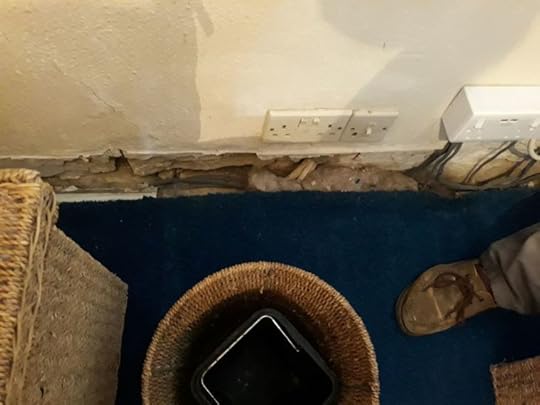 The gap in the skirting board where some of the treasure was foundSome of Phil and Sam’s ‘findings’
The gap in the skirting board where some of the treasure was foundSome of Phil and Sam’s ‘findings’ Original well
Original well Garden now
Garden now Garden through upper window
Garden through upper windowWe are lucky, the Pitt family, that so many of the places our ancestors lived in – both in England and Australia – not only still exist but have been or are in the process of being properly restored. It warms the cockles of my heart to think that Mary and her descendants still exist in the fabric of the houses they lived in and the cups they may have drank out of.
Patsy Trench
August 2020
The post May Cottage revisited appeared first on .
February 13, 2020
Australia’s bushfires
In my book Australia and How To Find It, published in October of 2019, I blithely claimed that Australia rarely featured in our news here in the UK, except for the cricket. That was before the bushfires. I have now added a postscript to my book chronicling the fires as witnessed in particular by residents of northern NSW, and the political fallout. Here it is:
For several months in late
2019/early 2020 Australia really did become the worst country in the world[i].
Between October 2019 and up until February 2020, as I write this, raging
bushfires have destroyed over 11 million hectares of land[ii]
(27 million acres, almost the size of England), over 2,500 homes, around 33
people including a number of firefighters, and an estimated one billion
animals. It was believed some wildlife species were wiped out altogether. Even
people not living near the fire regions were affected by smoke, which at one
point reached New Zealand and even travelled as far as South America.
It began early, in some cases in September, which is technically
spring in the southern hemisphere. I asked a friend, Michael Burge, who lives
in northern New South Wales and in the region of a local fire, to tell me his
story.
‘In very early September [2019] bushfires raged through Tenterfield and Drake, destroying homes and other property. Landowners, politicians and the media started throwing around the word ‘unprecedented’, mainly due to the speed and intensity of these unseasonal fires. . . .
. . . In November 2019 – still spring – fire ravaged two towns in our region (Wytaliba and Torrington) driven by the most intense air movement I have ever experienced. At one point during the terrible day when people were killed at Wytaliba, it felt like we were in the grip of two cyclones fighting for supremacy. The wind was so strong it was shooting into the ground and whipping up slices of soil that shot into the air. Dust, debris and burning foliage were being carried from where the fires were burning at Torrington, 28 kilometres away.Across the region, we heard of fires travelling ahead of themselves in the form of embers, anywhere between 12 and 40 kilometres ahead of fire fronts during the high winds.
According to climatologists, the hot air ahead of a fire can create a weather system known as a pyrocumulonimbus thunderstorm. I witnessed three of these. One showed on the horizon the day Tenterfield burned, its terrible lava-orange core showing deep within a great cauliflower head. Another was blowing towards our home the afternoon the RFS [Rural Fire Service] messaged me and advised that I leave home or shelter in place, so all I could see of it was the eerie yellow glow that wrapped everything in its pathway.
As I enacted our fire plan and evacuated to Glen Innes, I saw the worst pyrocumulonimbus over Wytaliba. It looked like a mushroom cloud after an atomic bomb, although it was collapsing into itself, whipped up by the terrible wind. Collapsing over communities, livestock and wildlife; rivers, creeks and forests. Collapsing over everything I have ever known about living in rural Australia at a thousand metres above sea level in a cool-climate region.’
Wytaliba is a tiny community of around 100 people, living
off the grid and away from the public eye, with a school attended by 10
children. In thirty minutes on a Friday in November 2019 the whole place went
up in flames, obliterating twenty-five (mostly uninsured) homes, the school, a
bridge on the route in, cars, agricultural machinery, wildlife and two local
residents.[iii]
Journalists descended en masse, to
the dismay of the surviving residents, who’d gone to live there specifically to
avoid the maddening crowds. One of them described Wytaliba as ‘one big,
dysfunctional family’, where there were no property boundaries, no mobile
coverage, and everyone shared everything.[iv]
Within weeks Wytaliba had set up a Facebook page, which I
followed, where people were offering to donate everything from toys to clothes
to caravans, cars and quad bikes and free holidays for children. They also
offered differing views on the causes of the fires, the attitudes of
governments – federal and state – the relative uselessness of most insurance
companies and questions about compensation and whatever was happening to all
those millions of dollars people around the world had donated. One lady piled
the burnt and meagre remains of her house onto a truck and deposited them
outside Government House in Canberra in protest at their policy – or lack of –
on climate change. Fundraising events and morale-boosting community
get-togethers sprang up all over the place.
Most residents of rural Australia have a fire plan, or
should have. Here is Michael’s:
‘Our fire plan is simple. On the evening news every day the fire authorities issue a fire level warning for the following day (this has been in place since the Black Saturday fires in Victoria 2009). If the forecast is Catastrophic (the highest level) then the authorities cannot guarantee the survival of any building or structure, and we have agreed between us that we’ll leave early the following morning and get out of the area altogether. If it’s Severe or Extreme, we agree we’ll stay and keep a close watch on things.
We are not equipped to defend this property as we don’t have enough water pressure or a transportable water tank with a generator to hose water onto spot fires or walls of flame. It would be foolhardy to stay without being much better prepared. So, when we leave our property we prepare it by ensuring all doors and windows are closed, the power is off and any fuel or gas tanks (such as the barbecue) are stored away from the house. We have one bag pre-packed with documents, photographs and other irreplaceable mementos, and one bag pre-packed with water, dog food, spare clothing and protective blankets in case we encounter fire when we’re on the road. So when we leave it’s a matter of dogs and bags in the car, and we just go. We could leave in minutes if required. We have a second way out of our property by car if we get cut off by fallen trees along our main drive.’
Some regional towns are better prepared than others, and
open up community centres or sports grounds to act as temporary evacuations
centres.
‘Despite the support of service clubs and charities on the ground, there was a sense that communities were running out of steam pretty quickly due to the scale of the fires and the length of time critical support was required. Richard [Michael’s husband] cooked for the fire services on a few days and described the conditions as very under-staffed and disorganised. In many communities, volunteer fire fighters got no support and were left to find their own meals and drinking water, which has been a big eye opener during this fire season. The state of unpreparedness under the Morrison Government (federal) and the Berejiklian government (NSW state) has been shameful. It’s been a combination of “resourcing issues” (according to NSW Rural Fire Service Commissioner Shane Fitzsimmons) and, in Morrison’s case, just not listening to the experts who predicted this crisis months, years and decades ago.’
When the fires were almost at their worst, in December,
Prime Minister Scott Morrison quietly went on holiday to Hawaii, and it took
him a while to decide to return to his burning country and pay the odd visit to
affected areas, where he received what might be called a cool reception.
Bushfire sufferers and firefighters refused to shake his hand, locals told him
in direct Australian terms where he could go.
It wasn’t long since Morrison had imported a lump of coal
into Parliament and waved it in the faces of fellow parliamentarians and told
them not to be afraid of it. Coal rules Australia. 40% of their energy is
coal-fired and 7% comes from renewables.[v] In the UK 9% of our energy comes from coal
and 24.5% from renewables[vi].
(Not that we have anything to boast about, with a Prime Minister who has
confessed he doesn’t ‘get’ climate change.[vii])
By contrast Iceland is almost 100% renewable and Costa Rica, Norway and Sweden
are not far behind.[viii]
I even in the course of my climate change meanderings came upon an Australian
website whose sole purpose seems to be to put a stop to wind power and other
renewables because they’re bumping up domestic utility bills.
The right-wing Liberal government are climate change deniers
for commercial, economic reasons. Of course. Malcolm Turnbull, Morrison’s
predecessor, was years ago beaten to the leadership of the Liberal party (by
one vote) precisely because of his views on global warming. In 2018 he was
ousted from his position as PM for the same reason and replaced by a hard right
government of climate change deniers. Denial appears to be deeply endemic in
the ruling Liberal party, and remains so despite everything. To quote Michael
again:
‘Just like it’s hard for the government to convince all Australians that it planned well ahead of this fire crisis, it’s difficult to for all of us to see an effective plan to reduce Australia’s carbon emissions. The Morrison Government has announced a Royal Commission into the fires, at the same time as it’s relying on accounting tricks to meet this country’s agreements in the Kyoto Protocol. It appears there is no plan to tackle either issue, just strategies to minimise our efforts to change on both fronts.’
Yet like so many other issues – and this goes not just for
Australia but other countries like the US as well – the people and their
leaders don’t always see eye to eye. Australia’s statistics don’t include the
possible thousands of inhabitants living off-grid. And a lot of effort on the
part of individuals is going into finding weird and wondrous ways of harvesting
water from the air, or the sun, or who knows what.
For the time being temperatures in Australia have dropped,
rain has fallen in New South Wales and in Melbourne – which had its wettest
January on record I believe – and hailstorms the size of tennis balls have
battered Canberra, smashing cars, roofs, trees and a series of greenhouses
belonging to the CSIRO (The Commonwealth Scientific and Industrial Research
Organisation), ruining several years of research work.[ix]
Much of the rain has collected dust particles in the air and falls as mud. Dust
storms have enveloped country towns, falling ash has poisoned rivers and killed
thousands of fish. At the same time torrential rain has put out most of the
fires, and now firefighters are hard at work coping with floods. Tourists –
local and international – could not cancel their holidays fast enough.
But now the whole world knows a good deal more about
Australia than it ever did in my living memory. Maybe with the world’s eyes on
them the powers that be may start to look at things differently. Or just maybe,
once the fuss has died down, along with the fires – though since February is
still full summer in Australia it doesn’t pay to be complacent – the world will
forget all about Australia and life will just go on as before.
That’s if Australians will allow it.
© Patsy Trench
February 2020
~~~~~~~~~~~~~~~~
[i] The title of my first book about my family history in Oz
[ii] https://www.bbc.co.uk/news/world-australia-50951043 Elsewhere (on Wikipedia) it claims over 18 million hectares have been destroyed, SBS and The Telegraph estimate it at 5 million.
[iii] One of whom was described as a ‘grandmother’. Why this was deemed a relevant description of a 60-something-year old, with the possible implication that she was too old and frail – and maybe even stupid – not to be able to save herself is a moot point. (She was none of these things by all accounts.)
[iv] https://www.abc.net.au/news/2019-11-14/nsw-bushfires-inside-small-town-wiped-out-wytaliba/11702106 [accessed 10 February 2020]
[v] The rest is made up of oil and gas. 75% of energy generated in Australia comes from coal. I don’t understand what happens to the 35% that isn’t consumed. https://www.ga.gov.au/scientific-topics/energy/basics
[vi] Then rest comes from natural gas 41% and 21% nuclear. https://www.energy-uk.org.uk/our-work/generation/electricity-generation.html
[vii] According to Claire O’Neill, who was sacked – for unspecified reasons – from her position organising a UN climate change conference in Glasgow later in 2020.
[viii] https://www.clickenergy.com.au/news-blog/12-countries-leading-the-way-in-renewable-energy/ There’s some variation in percentages between online sources but the country rankings are much the same.
[ix] https://www.theguardian.com/weather/2020/jan/21/canberras-destructive-hailstorm-wipes-out-years-of-csiro-research
The post Australia’s bushfires appeared first on .
February 10, 2020
Self publishing for family historians (again)
This is an update of my previous blog (click here for the original) for the friendly attendees of a workshop on Self Publishing for Family Historians at the Society of Genealogists on Saturday 8 February 2020.
First of all, an apology. I misled you concerning inserting images into a paperback. I was confusing paperbacks with ebooks.
To insert an image into a paperback all you need to do is to click Insert where you want the image to go, click on Picture, choose your image, and Bob’s your uncle.
It’s best to make sure the image is the right size before
inserting it into the page. If you try to alter the size after you’ve inserted
it you may lose resolution. As I remember when I did this it this involved a
bit of toing and froing to get the size and position of the image right.
NB: This is for black and white images only. For colour you
will need to choose the colour print option on Amazon’s website, and I imagine
this will bump up the price somewhat.
Here’s a link to Amazon KDP’s instructions: https://kdp.amazon.com/en_US/help/topic/G202169030#tips
###
Recommended and reputable organisations who can help you with any or all aspects of your self publishing adventure:
MATADOR: https://www.troubador.co.uk/matador/
SILVERWOOD: https://www.silverwoodbooks.co.uk/
I AM SELF PUBLISHING: https://www.iamselfpublishing.com
PYNTO: https://www.pynto.co.uk/ A friendly wife-and-husband team who can design any kind of book you like, from basic to custom-made.
LIFELINES PRESS: http://www.lifelinespress.co.uk/ A bespoke, personal service for print books only, offering everything from ghost writing to editing to the end production of a beautiful work of art, printed on paper of your choice, hand-bound in leather or anything else you choose.
Before you approach any of these companies:
What you need to think of
EDITING: There are three main types of
editor:
Structural edit – checking the manuscript as a
whole for clarity, over-writing, under-writing, repetition, overall structureCopy editing – line by line checking for
grammar, clumsy writing, repetition, clarityProof reading – checking for mistakes
and typos
There is a certain amount of blurring between these three tasks, but do not expect an editor to proofread your book. She/he may correct mistakes if they spot them but it is a different process altogether, and one a sharp-eyed friend might be able to do for you.
Alliance of Independent Authors (ALLi) https://www.allianceindependentauthors.org/members/content/partner-directory recommendations for editors, formatters & cover designers (members only, but for a small fee non-members can access the partner directory). Annual membership is £75.The Literary Consultancy: https://literaryconsultancy.co.uk/editorial/readers-2/Cornerstones: http://cornerstones.co.uk/uk/our-editors/
COVER DESIGN
https://www.jessicabelldesign.com/ Europe-based. Jessica Bell.https://www.99designs.co.uk UK-based. Your cover remit is ‘put out to tender’ to a number of designers who are invited to submit their designs, and you get to choose your favourite. The more you pay the more designers you are likely to attract. This has the advantage of being able to choose between several completely different approaches. http://www.lawstondesign.com/index.html UK-based. Rebecca Lawston. https://www.pynto.co.uk/ See above
BOOK INTERIOR:
Find a book whose layout you like to use as a template.
Consider:
SIZE: Of the book; standard non fiction is 6”x 9”, fiction 8”x 5” (but you can choose what you like). TYPEFACE AND TYPEFACE SIZE: There are specifically recommended fonts. I used Palatino 11 point. It’s not a bad idea to print out a few pages in various typefaces and sizes in your chosen page size to see what it looks likeMARGINS: Mine were quite generous at: top, bottom 1.9cm, inner 2 outer 1.5, gutter .33CHAPTER TITLE LAYOUT: Centred or left-aligned, upper or lower case, etc.TRIMMINGS: Drop caps, headers, small caps etcIMAGES: (photos, maps, family trees)
FRONT MATTER: What goes before the main text. This is a matter of choice, but for ebooks certainly it’s good to keep it to a minimum. Mine consists of:
Title pageCopyright pageDedication/quote pageTable of contentsPhoto of the subject of my book
END MATTER: What comes after the main text.
AcknowledgementsAppendix & chapter notes/referencesBibliographyIndexAuthor biography
You can also include reviews, if you have them, or books
you’ve already written.
AUTHOR BIOGRAPHY: This is important to readers,
so it’s a good idea to make yourself sound interesting and likeable!
Keep it briefTo the point and in the context of the book.Write in the third person
BLURB: The blurb is what makes a person read
a book or pass on.
Again, keep it brief – no more than 200 wordsWrite in the third person present tenseRemember it is a selling tool not a synopsis, so don’t attempt to tell the whole story
The blurb also acts as a reminder of what excited you enough to write the book in the first place.
SUBMITTING YOUR MANUSCRIPT
The two major players are
Amazon KDP (Kindle Direct Publishing): https://kdp.amazon.com/en_US/
Ingram Spark: https://www.ingramspark.com/
Both organisations publish in print and ebook form.
Amazon: free to submit, easy to navigate, they provide you with a free ISBN (or ASIN).Subsequent updates and changes, to the interior or cover, are also free.
Ingram Spark: fee of $49 to submit – unless you are a member of ALLi, in which case it’s free), and you need to have your own ISBN (through Neilsen: https://www.nielsenisbnstore.com/). Advantages of Ingram over Amazon are a) the quality is very slightly better, b) they have print outlets in the UK and Australia, c) they have a wider range of sizes and quality, including hardbacks.
Amazon has around 85% of the market but many people, including bookshops, don’t like them.
In both cases you upload your manuscript as one document (in Word), and your cover separately (as a pdf). You enter your title, author name. Chose categories and keywords, decide pricing. Make sure you fill in your tax details so you are exempt from US tax.
I will be adding details on ebooks shortly. I will also be updating my blogs on formatting.
Meanwhile, happy publishing!
Patsy Trench, February 2020
The post Self publishing for family historians (again) appeared first on .
December 1, 2019
Sex and the older woman
Q: So – sex and the older woman, is that what Claudia Faraday is about?
A: Partly, yes.
Q: And is this her?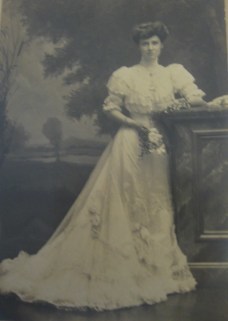
A: No, this is my great grandmother. She’s of a similar era.
Q: The book is taken from Claudia’s diary, is that right? How did it come about?
A: Through Claudia’s great granddaughter. She arrived on my doorstep one day with this diary she’d discovered in the attic of the family home she was clearing. It was her idea I read it and see if I thought it might be publishable. Once I’d got the hang of the tiny writing and the weird and wonderful way Claudia skirted round the more intimately personal stuff I couldn’t put it down.
Q: Claudia Faraday is not her real name. Why did you change it?
A: On request, to protect her reputation.
Q: So the contents of the diary were pretty salacious.
A: Slightly scandalous, is how I’d put it. It’s about a middle-aged mother of three discovering the joys of sex for the first time, and how that changes her view of the world.
Q: Would you describe it as erotica?
A: If people are looking for erotica they will be disappointed. It isn’t Fifty Shades of Grey. But it is a bit naughty, yes.
This is a woman who was brought up in Victorian times – long skirts, corsets, tidy hair and impeccable behaviour – when sex was considered a duty rather than a pleasure, and only for married women, of course. There were plenty of women like Claudia, who never discovered that sex could be fun, and joyful, and fulfilling. Who’d never heard of the clitoris let alone known what it could do. Marie Stopes was just emerging onto the scene with her book Married Love, where she made the shocking assertion that there was nothing wrong with indulging in sex for pleasure, not just for procreation. That is what is so intriguing about Claudia’s story.
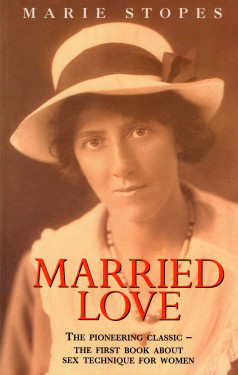
But what’s equally if not more fascinating is having experienced her first sexual orgasm and discovered, in a rather unlikely way, that sex was not just lying back and thinking of England, Claudia’s life takes on a whole new meaning. Not only does she see things more clearly – literally – but it jolts her out of the semi-torpor that her life has fallen into now her daughters have left home and she’s on her own with a husband working overseas. So she discovers things about herself, and her friends, she was unaware of.
Q: So if Claudia’s husband is overseas that implies her sexual awakening is not at his hands, so to speak. Does that mean her marriage is over?
A: You’ll have to read the book to find out.
Q: You make references to Virginia Woolf’s Mrs Dalloway – why is that?
A: For fun. As I was reading the diary I kept thinking of Mrs Dalloway, who was of a similar age to Claudia. I had to do some background research into the 1920s while I was writing the book, so I embedded references to some of the books and films of that period such as Mrs Dalloway and Lady Chatterley’s Lover, Evelyn Waugh’s Vile Bodies, etc. etc.
Q: What about Noel Coward? Did he appear in the diary?
A: No, I made that up.
Q: How much of it did you make up?
A: As I said a lot of Claudia’s writing was elliptical, she referred to events and people in a roundabout way which made me wonder whether, even if she wasn’t deliberately writing for publication, she was aware that people might find her diary and at least read it, if not publish it. For example, the ‘inciting episode’ that sets the whole thing off: the surprise visit by a stranger – I could show you what she actually wrote, and you’d be hard-pressed to really know what happened. It’s only as the rest of her story unravels that I was able to imagine what went on between the two of them.
Q: I’m curious to know more about Gabriel, the ‘messenger’. Is that why you called him Gabriel?
A: Absolutely. Because that is what he is. The stranger who arrives out of the blue, delivers his dynamic message and goes again, never to reappear. Just as Gabriel did with the Virgin Mary. A lofty comparison, I realise, but it fits. Except he doesn’t make Claudia pregnant. That would be a miracle too far.
Q: But who is he exactly? Is he really a colleague of her husband’s? In which case, did he send him? Or is he a kind of mythical figure?
A: That is a very good question: who exactly is Gabriel? The best answer I can come up with is he’s whoever you think he is. He is the catalyst, the instigator, the one who turns Claudia’s life around without becoming a part of that life. The basic plot is a familiar one: the stranger who arrives out of the blue and changes people’s lives. He’s the Inspector in An Inspector Calls – did he really exist? Or did he emerge from the family’s conscience?
Q: How easy is it to write about over-age sex?
A: ‘Over-age sex’, I like that! It’s no different to writing about any-age sex. If a woman – and a man – still have a sex drive in their fifties, or older, then what’s wrong with writing about it? I’ve used a wee bit of irony, because it’s taken Claudia so long to discover the fun in it. The whole book is a lighthearted take on sex in the 1920s, you could say.

Available as an ebook at Amazon
and in paperback at Waterstones, Foyles, The Book Depository,
Wordery, Booktopia and Angus & Robertson (Aus)
The post Sex and the older woman appeared first on .
November 5, 2019
NaNoWriMo
In November three years ago I sat
down to attempt the NaNoWriMo challenge of writing 50,000 words of a novel in a
month. I had heard of the National Novel Writing Month before but dismissed it
as a gimmick. In the event it turned out to be a surprisingly positive
experience, especially for a writer like myself who has a tendency to go back
over stuff until that opening chapter is absolutely
perfect.
The great thing about NaNoWriMo is that it keeps you moving forwards all the time, even if like me you have no idea where your novel is heading. All I had was a character, Prudence, best friend of the subject of another novel I had written, set in 1920s England, about a woman discovering the joys of sex in her fifties. (I wrote about Claudia for Books for Women back in 2016 – http://booksbywomen.org/writing-about-sex-and-the-older-woman/) At the end of the month I hadn’t quite achieved the 50,000 words but my novel, or rather my character, had taken me to all sorts of totally unexpected places, including espionage in World War I, the suffragists, the Bloomsbury set and all sorts.
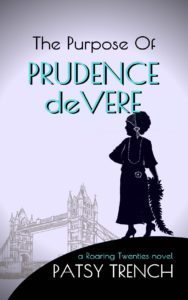
But there was a problem: having set my character up as a
free-thinking woman who as a result of an inattentive upbringing breezed
through life without rules, boundaries, plans or purpose, I realised my novel
did not have a story. That’s to stay a well-structured
beginning-middle-and-ending, with an inciting incident that set off rising
action to a climax and back down again to resolution; where the main character
goes on a journey and ends up other than where she started. In other words,
along with my protagonist, the novel itself had no purpose.
I wracked my brains to come up with an Idea, but I soon
realised it’s not something you can do in retrospect. That’s like being able to
add the crucial ingredient to a cake after you’ve baked it. So in the end I did
the only thing I could think of – I made a virtue out of what could be regarded
as a drawback: I made the lack of purpose a feature of the book, I even used it
in the title – The Purpose of Prudence de Vere.
If you google the word purposelessness, which I did in order
to look for quotes for the book, you will find it is invariably regarded as A Bad
Thing. A life or a person without purpose is not worth a pin. And yet my novel
is a happy thing and my purposeless central character is – if you think of it
in these terms – a model of mindfulness. She lives in the moment. She is open
to surprise. She is open, period. She lives her life spontaneously, according
to whim and happenstance. She is a lot happier than I am. To tell the truth I’d
rather like to be like her.
Would more of us be happier if we took life as it comes? If
we were not driven, often blinkered, by some purpose that we’ve invented for
ourselves in order to have a reason to get up in the morning?
Discuss.
© Patsy Trench
This article first appeared in booksbywomen.org
The post NaNoWriMo appeared first on .
October 9, 2019
Marketing books
I have been writing and publishing books since 2012. So far I have five books under my belt: two non-fiction about early colonial Australia, two novels set in 1920s England about women behaving badly, and a short piece – in ebook only so far – of random stories about Australia. But in all those nine years I have never managed to get my head around marketing.
 Sketch by Anna de Polnay
Sketch by Anna de PolnayThe Australian books have sold relatively well, with the
help of the odd review in magazines and articles I penned in local newspapers,
plus a radio interview and a couple of book promotions organised by friends and
acquaintances in Australia. I did virtually no other promotion. This is easy, I
thought.
My first novel on the other hand sold virtually no copies at all. None. So I set to to learn about promotion. I read books, I watched webinars, I attended seminars and gatherings with fellow authors, joined ‘author-entrepreneur’ mailing lists and followed them on social media. I’ve spent almost as many hours trying to learn about promotion as I have writing, and yet I’m still no nearer getting the hang of it; and the reason is partly what I call Switch-off Syndrome, otherwise known as SOS.
SOS usually happens within ten minutes of any webinar or
book I’m trying to concentrate on. It tends to kick in at the first acronym,
which is usually something like CPC or CTR, or ROI. (Cost per click, Click-through
rate and Return on investment – don‘t ask.) While these clever people are
chatting away brightly about their children and their pets and how they made
their first million, I have drifted into a catatonic trance that nothing can
penetrate.
It happens with weather forecasts too. You really really want to know what the weather’s going to be like tomorrow so you switch on the radio, only to find you haven’t heard a word they said – mostly because they began with a region that was not yours and so you mentally Switched Off and therefore missed the bit that you wanted to hear.
The other problem is the way these clever authorpreneurs –
yes, the word exists apparently – are so clued up about algorithms and CPCs and
so on they don’t necessarily appreciate how the rest of us, who have only just
about got their head around the notion of keywords and metadata, haven’t got the
faintest idea what they’re talking about. And of course if they have to fill a
whole book, or an hour and a half’s webinar, they aren’t necessarily trying to
get to the nitty-gritty as quickly and concisely as possible. There’s a lot of
banter, and jokes, and for someone like me with the attention span of a flea
that can be a problem.
And when it comes to putting their excellent advice into practice I always but always fall at the first technical hurdle. They make it sound so easy, and it isn’t. I would rather do virtually anything, including visiting the dentist, than work on promotion.
 What I would actually rather be doing
What I would actually rather be doing(sketch by Anna de Polnay)
So I have decided to expose myself. I am going public with my conundrum, in this blog, in the hope that I will shame myself into cracking the problem. I suspect I am not the only one who feels like this – and if you’re out there and reading this, let me know. I’m going to keep a diary, publicly, of my marketing attempts, with brief explanations and results, for my own sake if not for anyone else’s.
After all as many people have said, there’s not a lot of
point in writing books if nobody is buying them.
Wish me luck.
© Patsy Trench
The post Marketing books appeared first on .



